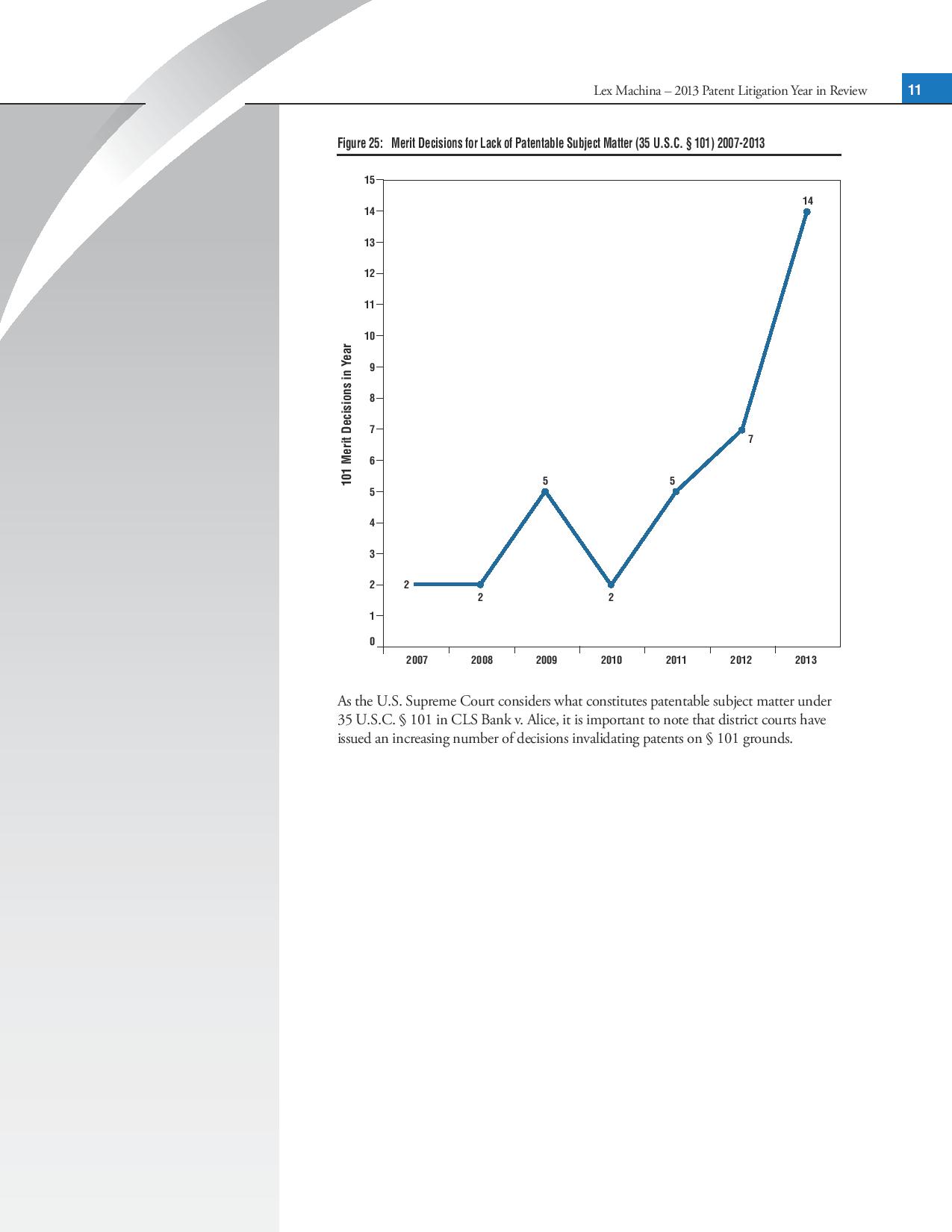By Rakesh Sharma. This article originally appeared on Forbes, May 14, 2014.
Big data meets patent litigation in legal analytics firm Lex Machina‘s report about 2013 in review. The report, which was released earlier this week, trots out interesting, though unsurprising, statistics.
For example, the number of new patent cases in district courts showed a 12.4 percent increase to 6,092 cases last year. However, that number might be misleading. According to the Owen Byrd, general counsel at the firm and author of the report, the increased figures can be attributed to a court directive from the previous year that made it mandatory for parties to file separate claims for each patent, instead of bunching them together into a single suit to save costs.
With 1495 cases in its jurisdiction, the Eastern District of Texas, a favorite hunting ground for such cases, retained its favored status from the previous year. On the other hand, the Central District of California fell out of favor with litigators with a 20 percent drop in cases filed from the territory. And, the most frequently asserted patent relates to logistics and email alerts.
But, those numbers are only part of the story. The report illustrates four far more interesting stories about patent litigation trends last year.
iLitigate Apple?
The Apple brand is a favorite not only with consumers but also with litigators. With 59 patent claims filed against it, the Cupertino-based company had the dubious distinction of being the most-sued company in 2013. Based on my conversation with Byrd, there might be two reasons for this. The first one is related to the company’s financial health. “Apple is perceived as a deep pocket by NPEs (or, non-practicing entities),” says Byrd, adding that the company settles claims more “frequently” and “quickly.” Available data from the Lex Machina database, which is a combination of private and public databases such as PACERs, corroborates Byrd’s claim: Apple took less than a year on average to settle patent-related claims.
Interestingly, despite media attention and talk of litigation across continents, the Apple- Samsung battle constitutes less than one percent of Apple’s patent litigation load. Byrd contends that the media has been distracted by the large damage awards awarded to Apple by juries recently.
Delaware: The New Eastern District of Texas?
That Delaware is a popular site to incorporate startups is an already known fact. In recent times, however, the district is also becoming a popular destination for litigators: it experienced the highest increase in patent-related litigation, almost 33 percent, amongst all jurisdictions. It also accounted for more than half of all patent trials held last year. According to Byrd, the increase can be attributed to the presence of sophisticated jurisdiction and jury pools or jury members who are more likely to understand the nuances of patent litigation. “Patent litigation is a more technical-type of lawsuit and savvy defendants or plaintiffs prefer jury and judges who are knowledge about corporate IT and other technical subject matter,” says Byrd. Unlike the Eastern District of Texas, which has earned a reputation for being pro-plaintiff, Delaware has had an equal percentage of wins and losses for plaintiffs and defendants in recent years.
Tea Leaves Or Low Quality Patents?
The number of cases winding their way to the federal and supreme courts has been steadily decreasing over the years. This is primarily due to patent invalidity judgements at the district level. The number of such judgements showed a sharp increase of almost 300 percent in the last two years. A majority of these judgments were 101 judgements, or judgements made due to lack of patentable subject matter. Byrd has two theories for the increase. “Perhaps, the district judges are trying to read the tea leaves at the Federal or Supreme Court level,” says Byrd. In other words, they are basing their judgements on precedents at the higher courts. His other theory for the increase, however, is more controversial. “The USPTO is issuing more low-quality patents since the number of cases being rejected on 101 grounds has gone up at a significant rate,” he says.

Judge Rodney Gilstrap: An Overworked Judge?
Judge Rodney Gilstrap from the Eastern District of Texas is a hardworking man: he is working on 941 patent-related cases in his jurisdiction. The number represents an astounding difference of 543 cases between him and Judge Leonard Stark from Delaware, who has been assigned 399 such cases. “That is a big blinking red light,” says Byrd. According to him, the judge could not have been assigned so many cases without his consent. “Clearly, he wants to be known as a patent law expert,” says Byrd, adding that the judge may succeed in “bullwhipping” several cases into an early settlement. This strategy works well for defendants, who prefer to settle early and refocus energy on their business and products.
